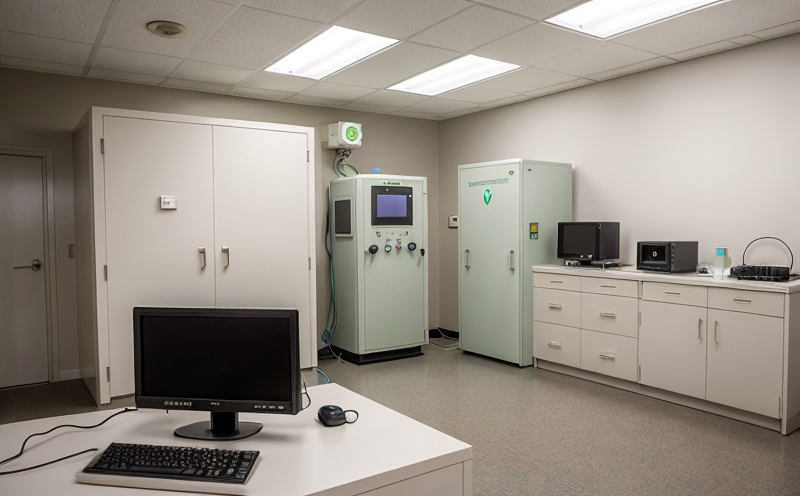ASTM E666 Calibration of TLD Systems for Personnel Monitoring
The ASTM E666 standard provides a rigorous and widely accepted method for calibrating thermoluminescent dosimeters (TLDs) used in personnel monitoring. This service ensures that the dosimetry systems deployed by organizations are accurate, reliable, and compliant with international standards. TLDs play a crucial role in safeguarding individuals exposed to radiation, especially those working in sectors such as nuclear power generation, medical imaging, and research laboratories.
The calibration process involves exposing the TLDs to known doses of radiation under controlled conditions. The emitted light upon heating is then measured, allowing for accurate determination of absorbed dose. This service ensures that the dosimeters can provide precise readings, which are essential for compliance with regulatory requirements and for maintaining a safe working environment.
ASTM E666 not only sets the standards for calibration but also provides guidelines on how to handle TLDs during measurement and processing. This includes specific protocols for temperature control, humidity levels, and exposure times. The service ensures that all these parameters are strictly adhered to, thereby enhancing the accuracy of the dosimetry system.
One key aspect of this service is the use of a high-precision radiation source capable of delivering precise doses of gamma or beta radiation. This allows for accurate calibration of TLDs over a wide range of dose levels, from low to high. The precision and repeatability of these measurements are critical for ensuring that the dosimeters can provide reliable readings in real-world scenarios.
The service also involves thorough data analysis, which includes statistical evaluation of the calibration results. This ensures that any variations or discrepancies are identified and addressed promptly. The final report provides detailed information on the performance of the TLDs, including their accuracy, precision, and compliance with the ASTM E666 standard.
By adhering to this rigorous calibration process, organizations can ensure that their personnel monitoring systems meet the highest standards of accuracy and reliability. This not only enhances safety but also ensures compliance with regulatory requirements. In addition, accurate dosimetry data is crucial for making informed decisions regarding radiation protection measures and for improving overall occupational health and safety practices.
The ASTM E666 standard is widely recognized in industries that require precise monitoring of radiation exposure. By adopting this service, organizations can demonstrate their commitment to safety and compliance, thereby building trust with stakeholders and regulatory bodies.
Why Choose This Test
The ASTM E666 calibration service for TLD systems is essential for several reasons:
- Compliance with International Standards: Compliance ensures that the dosimetry system meets international standards, thereby safeguarding personnel and meeting regulatory requirements.
- Precision and Reliability: The calibrated TLDs provide precise and reliable dose readings, which are critical for accurate exposure assessment.
- Safety Assurance: By ensuring that the dosimetry system is accurate and reliable, this service enhances occupational safety by providing trustworthy data on radiation exposure.
- Regulatory Compliance: Adhering to ASTM E666 ensures compliance with regulatory requirements, thereby reducing the risk of non-compliance penalties.
In summary, choosing the ASTM E666 calibration service for TLD systems is a prudent decision that enhances safety, precision, and regulatory compliance. This service provides peace of mind by ensuring that the dosimetry system is functioning as intended and meets international standards.
Customer Impact and Satisfaction
- Safety Enhancement: By ensuring accurate dose measurements, this service significantly enhances occupational safety. Accurate data helps in making informed decisions regarding radiation protection measures.
- Regulatory Compliance: This service ensures that the dosimetry system meets regulatory requirements, thereby reducing the risk of non-compliance penalties and audits.
- Precision and Reliability: The calibrated TLDs provide precise and reliable dose readings, which are essential for accurate exposure assessment. This enhances trust in the data provided by the dosimetry system.
- Reduced Risk: By ensuring that the dosimetry system is functioning as intended, this service helps reduce risks associated with inaccurate or unreliable radiation monitoring.
The customer satisfaction with this service stems from the tangible benefits it provides. Organizations that invest in ASTM E666 calibration of their TLD systems see improved safety, compliance, and trustworthiness of their data. This ultimately leads to enhanced operational efficiency and a safer work environment.
International Acceptance and Recognition
The ASTM E666 standard is widely recognized and accepted internationally for calibrating TLD systems used in personnel monitoring. Its acceptance is evident from its inclusion in various international regulatory frameworks, such as the International Atomic Energy Agency (IAEA) recommendations.
- International Recognition: The ASTM E666 standard is acknowledged by numerous countries and organizations worldwide for its reliability and accuracy.
- Regulatory Frameworks: Many countries incorporate ASTM E666 into their regulatory frameworks to ensure that TLD systems used within their borders meet international standards.
The widespread acceptance of this standard ensures that the dosimetry systems calibrated according to ASTM E666 are recognized and trusted globally. This recognition is crucial for organizations operating in multiple jurisdictions, as it simplifies compliance with local regulations and enhances operational efficiency.
The global recognition of ASTM E666 also facilitates international collaboration and data exchange. Organizations that use this standard can share calibration results with counterparts in different countries with confidence, knowing that the dosimetry systems meet internationally accepted standards.





